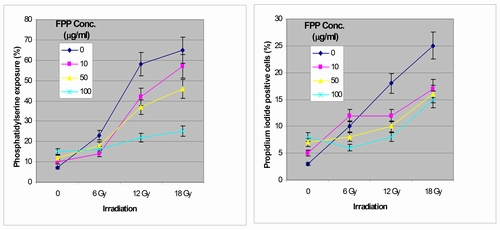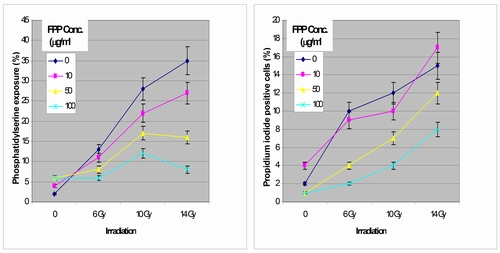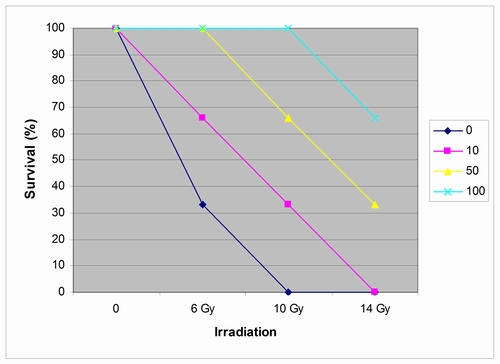News&Topics
Radio-protective effect 【second report】
In this report we summarize results of a study regarding the effect of FPP on radiation-induced damage in cultured cells and in mice.
Irradiation was carried out in a Gammacell 220 (MDS Nordion, Excel, Canada).
【In vitro studies】
Human foreskin fibroblasts were seeded in 96-well plates, 2000 cells/well. After overnight incubation, the cells attached, and the plates were irradiated by at 4 doses: 0, 6, 12 and 18 Gy. After irradiation, FPP, at concentrations of 10, 50 or 100 µg/ml (sterilized through a 0.22 m filter), was added to each well, and the cells were incubated for 2 or 3 days. Cell survival was estimated by CellTiter 96 Aqueous Non-Radioactive Cell Proliferation assay for cell vitality.

Additional experiments were carried out on human HL60 cells growing in suspension. The cells were irradiated at various doses and then treated with FPP. After 24 hr, phosphatidylserine exposure and propidium iodide staining (markers of apoptosis and cell survival) were measured.

【In vivo studies】
Mice were irradiated at various doses (0, 6, 10 and 14 Gy). The mice were then fed with FPP (by adding it to the drinking water). After 3 days, the marrows from the femur bones were obtained and phosphatidylserine exposure and propidium iodide positive cells were measured.

Mice were irradiated at various doses. The mice were then provided with FPP (in the drinking water), and observed daily for 3 weeks.

【Conclusions】
The results suggest a significant protective effect of FPP on irradiated cells and mice.
【Possible mechanisms of operation】
Radiation-induced damage is mediated in part by free radicals, particularly free oxygen radicals (reactive oxygen species, ROS) [1]. Toxic ROS may also be generated by "labile iron" ("free" cellular iron not bound or stored in proteins such as hemoglobin and ferritin). These iron species participate in chemical reactions that generate ROS (Haber-Weiss and Fenton reactions).
FPP has been shown to have anti-oxidative potential. Recently, we have found that this is not just because of its ability to bind and remove ROS (as a scavenger), but also because of its ability to bind and remove (from the blood and from cells) excess iron (as a chelator) [2].
【Future Plans】
Based on the present results, and in order to prepare the data for publication, we believe that the following additional research is worthwhile regarding the specific protective effect of FPP on the DNA and mutagenesis. These aspects are important because of the long-term carcinogenic effect of irradiation.
In vitro experiments
Irradiated cells treated with FPP will be studied for oxidation of the guanine nucleotide (8-OHdG) in the DNA (a marker of DNA damage) and generation of hypoxanthine-guanine phosphoribosyltransferase (HPRT) mutants.
In vivo experiments
Irradiated mice under FPP-supplemented diet will be studied for 8-OHdG in the DNA in their peripheral blood leukocytes, and GPI- (negative) phenotype (a marker of genetic instability and mutations) in their red blood cells.
【References】
- Reizenstein P. Iron, free radicals and cancer. Med Oncol Tumor Pharmacother. 1991;8:229-233.
- Prus E, Fibach E. The antioxidant effect of fermented papaya preparation involves iron chelation. J Biol Regul Homeost Agents. 2012;26:203-210.
- 2013.01.08
- WHAT'S NEW
